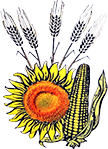The Effect of Crop Management Practices on the Disease Caused by Septoria tritici on Wheat Crops
Lidia Cană, Emil Georgescu, Gheorghe Măturaru
National Agricultural Research and Development Institute Fundulea
Keywords: wheat, foliar diseases, crop management practices.
Abstract: Septoria leaf blotch (caused by Septoria tritici) is one of the most important wheat diseases in Romania however its severity has varied significantly over the years.
Annual harvest losses due to diseases can reach up to 30%, its variations depend on climatic conditions, cultivar resistance and crop management.
Diseases control is a high priority in order to minimize yield and grain quality losses.
The aim of the present study was to determine the effect of different variants of management practices on the development of winter wheat leaf diseases.
Disease development caused by Septoria tritici was followed during the period 2018-2020, in trials located in the experimental field, at NARDI Fundulea.
The disease development was assessed in a four-factor experiment:
- (a) sowing season - 3 sowing seasons (early, optimal, late);
- (b) nitrogen fertilizers - 4 dose of nitrogen fertilizers (N0, N90, N150, N200);
- (c) soil tillage system - 2 variants of soil tillage (conventional tillage, minimum tillage);
- (d) crop rotation - 2 previous crop (wheat, rapeseed).
The variety of winther wheat used as biological material in these experiments was FDL Miranda.
A high variability of the climatic conditions during the three years of trial was registered, both in terms of temperatures and the amount of rainfall especially during April-May, when wheat is highly susceptible to Septoria disease. The significant effect of meteorological factors on the occurance and severity of foliar disease was registered.
The study highlighted that the monoculture, high doses of nitrogen, early or too late sowing and minimum tillage have led to an increase in the severity of wheat Septoria disease.
